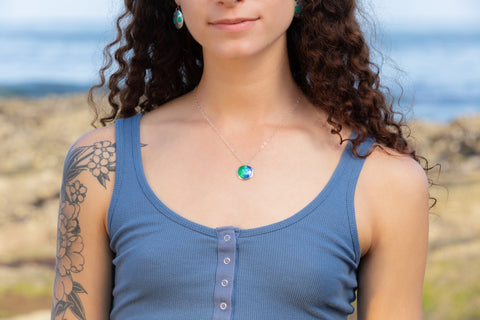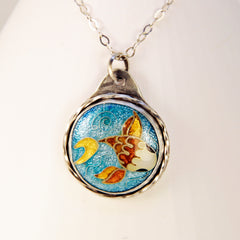What is Enameling?
Enameling is the ancient art of melting powdered glass onto metal. This can be done on flat pieces of metal or three dimensional pieces of art, such as vases. Heat is applied with a high temperature torch or a kiln. The temperature must rise to at least 1450 degree F. for the glass to fully fuse to the metal. For small pieces of jewelry, this fusing process takes approximately 30 seconds - 2 minutes. For larger pieces of metal, it can take much longer. However, artists commonly engage in many firings of a single piece to add layers onto both sides. Also, detailed designs often require many firings to obtain the desired artistic effects.

I learned metal-smith techniques before I decided to add enameling to my bag of tools. I wanted to be able to add color and dimension to my work without having to rely on stones. Enameling is an extremely versatile medium. You can create an endless variety of design elements.
Enamels come in various types: opaque, transparent, and opalescent. Other glass based products are also made to create additional effects such as metallic luster and Murrini glass. Opaques give a one-dimensional feel but can be very effective in certain designs. With transparent enamels, you can see through to the metal and you can layer, shade, and blend different colors. This adds tremendous interest to the work. Some artists paint with enamels, similar to fine art painting.
Besides basic enameling, I use cloisonne and champleve techniques. These are French words, but these techniques have been used in some form or fashion all over the world since ancient Greek times.
Cloisonne involves creating partitions with wires on top of a piece of metal and then filling these compartments with enamel. The metal is then fired until the glass fuses. After the artist adds all the layers of enamel desired, the partitions and glass may be ground down so that the entire surface is smooth.
Champleve, in contrast, involves making recesses into the surface of the metal. These recesses are then filled with enamel and fired. The final piece will be ground smooth. Instead of thin wires, larger sections of metal appear on the surface of the piece. These recesses can be created by etching and engraving into the metal. Or, the artist may fuse or solder two pieces of metal on top of one another. The top piece of metal has been "pierced" or sawed in a way to create openings which can be filled with enamel and fired.


